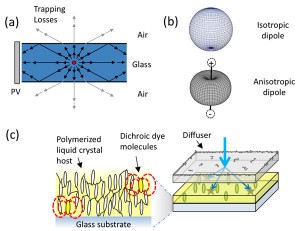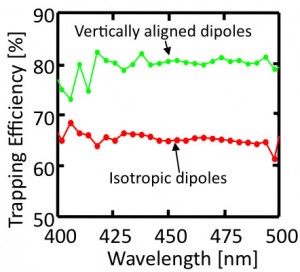Vertical Dye Alignment in Luminescent Solar Concentrators for Improved Trapping Efficiencies
Figure 1: (a) A schematic representation of a luminescent solar concentrator. The trapping efficiency is defined as the fraction of photons emitted from the edge versus photons emitted from the face and edge combined. (b) The emission profile of isotropic dipoles and a linearly aligned, anisotropic dipole. The absorption and emission profile of isotropic dipoles is uniform, while the anisotropic dipole emission is characterized by a sin2θ profile. (c) In order to improve the performance of LSCs, we align rod-shaped dichroic dye molecules perpendicular to the waveguide. An external diffuser is used to correct for the reduced ability to absorb light that is incident perpendicular to the waveguide.
Luminescent Solar Concentrators (LSCs) aim to reduce the cost of solar electricity by using an inexpensive collector to concentrate solar radiation without mechanical tracking (Figure 1a) [1]. Ideally, the dyes re-emit the absorbed light into waveguide modes that are coupled to solar cells (black arrows). However, some photons are always lost, re-emitted through the face of the LSC, and coupled out of the waveguide (grey arrows). In this work, we improve the fundamental efficiency limit of an LSC by controlling the orientation of dye molecules using a liquid crystalline host. Conventional LSCs employ randomly aligned dyes that collectively emit photons isotropically; see Figure 1a. This dye emission profile yields a trapping efficiency of ηtrap ~ 0.75 for a waveguide refractive index of ηS = 1.5. Instead, it is possible to align the dyes vertically so their transition dipoles couple more strongly into the waveguide, as illustrated in Figure 1b. We employ a homeotropic liquid-crystal matrix to align rod-shaped dye molecules perpendicular to the waveguide, as illustrated in Figure 1c. Orienting the molecules at a right angle to the surface reduces the absorption of perpendicular incident radiation. Consequently, we employ an optical diffuser above the LSC to scatter incident light.
Figure 2: The measured trapping efficiency, ηtrap of the isotropically aligned LSCs (red dots) and the vertically aligned, homeotropic, LSCs (green dots). This measured ηtrap is the ratio between the measured number of photons emitted from the edge and the total number of photons emitted from the face and edges.
We have enhanced the overall performance of LSCs by 16% by aligning the dipole moment of dye molecules perpendicularly to the waveguide. The improvement is due to an increase in trapping efficiency. We measure ηtrap = 81% for an LSC employing vertically aligned dye molecules, compared to ηtrap = 66% for an LSC based on randomly oriented dye molecules (see Figure 2). The increase is consistent with theory that models the system using Hertzian dipoles embedded in a waveguide. This theory also predicts small but significant changes to the commonly-cited trapping efficiency of LSCs employing isotropic dipoles [2].
References
- J.S. Batchelder, A.H. Zewail, and T. Cole, “Luminescent solar concentrators. 2: Experimental and theoretical analysis of their possible efficiencies,” Applied Optics, vol. 20, pp. 3733-3754, Nov. 1981. [↩]
- C. L. Mulder, P. D. Reusswig, A. M. Velázquez, H. Kim, C. Rotschild, and M. A. Baldo, “Dye alignment in luminescent solar concentrators: I. Vertical alignment for improved waveguide coupling,” Optics Express, accepted for publication. [↩]

